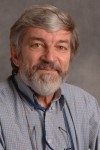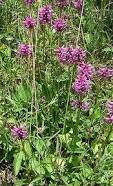When thinking about heterocyclic chemistry it’s as interesting to consider where it came from as what it is and what it can do. Probably the most important origin of heterocyclic chemistry is compounds from plants and it’s their medicinal properties that first became significant. Most people will be aware of the eastern medicine traditions of China and India that rely heavily on plants but it’s less widely known that some of this knowledge travelled west and can be found in Latin documents and even in Old English. Herbals were written in these islands in Old English and Latin between the 8th and 12th centuries and one, in Old English, contains a very recognisable plant that produces a well-characterised heterocyclic compound. The compound is known as betonicine and the plant itself is betony. It was used as an analgesic 1000 years ago and is still available commercially from herbalists today. So I thought it would be a good idea to talk to my Strathclyde resident plant chemistry expert, Professor Sandy Gray, about the field of phytochemistry and his interests.
Betony, the plant described in the Old English Herbal
Sandy, what attracted you to study phytochemistry in depth? – I saw members of my own family and my home community in the Cayman Islands treated with herbal medicines (traditional treatments) when orthodox treatments may have failed. With many of the traditional plant remedies the active principles and how they work were and still are unknown so this prompted me to pursue this as a research career in drug discovery.
You’ve been all over the world prospecting for and collecting plants. Where have you been and where’s been most interesting? – I have travelled in Africa, Asia, the Caribbean, Europe, the Middle East and South America. Perhaps one of the most interesting and exciting countries from every point of view for me was Colombia. This is a country of high biodiversity in every sense of the word with the high Andes ranges with Alpine and Páramo vegetation and the tropical rainforests of the Orinoquía and Amazon regions boasting more than 80 distinct human cultures and languages. Some of my most memorable experiences have been working with the Indigenous communities in Amazonia particularly with Muinane, Uitoto and Yukuna people. Most of the plants that my group have worked on were plants collected by the students themselves, usually a post-graduate, wishing to be trained in phytochemical and bioassay-guided methods of drug discovery. We’ve collected a library of compounds from 80 countries in 5 continents, a really remarkable resource.
Plants certainly have provided the starting points for many drugs going back nearly 300 years in western medicine. Is there really more to be discovered out there? – Plants have been the source of many useful drugs including the analgesics morphine and codeine, the anti-cancer agents vinblastine, vincristine, and paclitaxel, the anti-malarials quinine and more recently artemisinin. Clever heterocyclic chemistry is often needed to yield new and sometimes more effective or appropriate drugs. In one instance a medical doctor brought a plant sample that he used traditionally (probably from Ayurveda) to treat psoriasis. My colleagues thought I was daft to take on the project, more or less that we would not find anything new, as the plant already had more than 200 publications on its chemistry. One of the active substances isolated by us was a novel structure, later patented by the University!
You mentioned a compound from the Indian Ayurvedic medical systems, which is thousands of years old. Are there things we can learn from that them? – All of the traditional medicine methodologies used globally have taught us all a lot and, in fact, will continue to teach us and show us the way.
Natural products chemistry has been a great tradition at Strathclyde. Can you tell us about some of the exciting things that have come out from recent research? I was approached some time ago by a biochemist colleague who was asking me for a particular compound that he wished to use as a ‘standard’ in one of his anti-inflammatory screening bioassays. When I told him that I did not have the substance requested he asked me to suggest a few compounds that might be similar to compound he requested. I chose 10 natural compounds with a variety of structures from my collection and, when tested, 4 of the compounds were found to be active, one very significantly. This became one of the starting points of a big anticancer drug discovery project at Strathclyde led by our colleague, Simon Mackay, and funded by the Cancer Research Campaign.

Thank you, Sandy. And that’s great continuity because I’ll be talking to Simon next month.
Professor Colin J Suckling OBE DSc FRSE
Research Professor of Chemistry
Department of Pure & Applied Chemistry
University of Strathclyde
295 Cathedral Street
Glasgow G1 1XL
T 0141 548 2271
F 0141 548 5743









